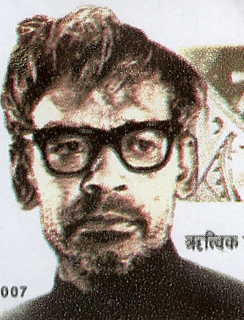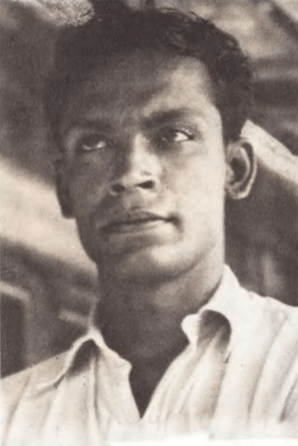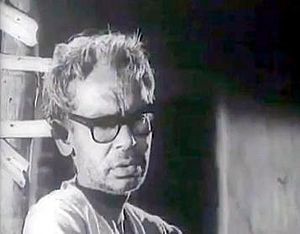Ritwik Ghatak facts for kids
Quick facts for kids
Ritwik Ghatak
|
|
|---|---|
 |
|
| Born |
Ritwik Kumar Ghatak
4 November 1925 |
| Died | 6 February 1976 (aged 50) |
| Education | Ballygunge Government High School, Rajshahi Collegiate School |
| Alma mater | Presidency College, Calcutta University |
| Occupation |
|
| Years active | 1952–1976 |
|
Works
|
|
| Spouse(s) | Surama Ghatak |
| Children | 3 |
| Relatives | Aroma Dutta (niece) Manish Ghatak (brother) Mahasweta Devi (niece) Parambrata Chatterjee (grandnephew) Nabarun Bhattacharya (brother's grandson) Bijon Bhattacharya (niece's spouse) |
| Awards | Padma Shri (1970) National Film Award for Best Story (1974) |
Ritwik Kumar Ghatak (4 November 1925 – 6 February 1976) was a famous Indian film director, writer, and playwright. He is remembered for showing real-life social issues, the impact of the partition of India, and women's roles in his films. He worked alongside other important Bengali filmmakers like Satyajit Ray and Mrinal Sen.
Ghatak won the National Film Award for Best Story in 1974 for his film Jukti Takko Aar Gappo. He also received the Best Director's Award from the Bangladesh Cine Journalist's Association for Titash Ekti Nadir Naam. In 1970, the Indian government honored him with the Padma Shri award for his contributions to the arts.
Contents
Ritwik Ghatak's Family
Ritwik Ghatak's son, Ritaban Ghatak, is also a filmmaker. He helps manage the Ritwik Memorial Trust. Ritaban has worked to restore some of his father's older films and finished a documentary that Ritwik had started.
Ritaban also made a film about his father called Unfinished Ritwik. Ghatak's elder daughter, Samhita, made a documentary called Nobo Nagarik.
Creative Journey in Film
In 1948, Ritwik Ghatak wrote his first play, Kalo Sayar (The Dark Lake). He also helped bring back the famous play Nabanna. Ghatak was a key leader in the cultural group of the Communist Party of India, called the Indian People’s Theatre Association.
He became well-known for his "partition trilogy" of films. These movies explored the painful division of Bengal in 1947. The films were Meghe Dhaka Tara (The Cloud-capped Star) from 1960, Komal Gandhar (E Flat) from 1961, and Subarnarekha (The Golden Thread) from 1962.
Ghatak started in the film industry as an actor and assistant director for Nimai Ghosh's film Chinnamul (1950). Two years later, he directed his first complete film, Nagarik (1952). Both of these films were big steps forward for Indian cinema. Ghatak's early films often mixed real-life storytelling with acting styles from folk theater.
In 1966, Ghatak taught at the Film and Television Institute of India (FTII) in Pune. Many of his students later became famous filmmakers themselves. These included Mani Kaul, Kumar Shahani, Adoor Gopalakrishnan, Saeed Akhtar Mirza, and John Abraham. During his time at FTII, he helped with two student films: Fear and Rendezvous.
How Ritwik Ghatak Influenced Others
When Ritwik Ghatak passed away in 1976, his biggest impact was through his former students. Even though he taught film for a short time, his ideas lived on. Students like Mani Kaul, John Abraham, and especially Kumar Shahani, shared Ghatak's ideas. These ideas were written down in his book Cinema and I. Famous director Satyajit Ray said this book covered all parts of filmmaking. Other students of his included Subhash Ghai.
Unlike Satyajit Ray, who became famous outside India during his lifetime, Ghatak's films were mostly known within India. Satyajit Ray tried to help promote Ghatak's work, but it didn't lead to international fame for Ghatak. For example, Ghatak's Nagarik (1952) was one of the first Bengali art films. It was made three years before Ray's Pather Panchali, but Nagarik was not released until after Ghatak's death in 1977.
His first film released to the public, Ajantrik (1955), was one of the first Indian films to show an object, a car, as a character. This was many years before the Herbie movies. Ghatak's Bari Theke Paliye (1958) had a story similar to François Truffaut's The 400 Blows (1959). However, Ghatak's film remained less known, while Truffaut's became a famous film of the French New Wave.
One of Ghatak's later films, Titash Ekti Nadir Naam (1973), used a "hyperlink format." This means it featured many characters in a group of connected stories. This was two years before Robert Altman's Nashville (1975), which also used this style.
Ghatak's only big commercial success was Madhumati (1958), a Hindi film for which he wrote the story. It was one of the first films to explore the idea of reincarnation. Many later films in India and around the world were inspired by it. For example, the American film The Reincarnation of Peter Proud (1975) and the Hindi film Karz (1980) both dealt with reincarnation. Karz was remade several times, including Karzzzz (2008). The hit Bollywood film Om Shanti Om (2007) was also directly inspired by Madhumati.
Ghatak's work as a director influenced many Indian filmmakers. His influence began to spread outside India in the 1990s. A project started to restore his films, and they were shown internationally. This helped him gain a global audience. In a 1998 poll by the Asian film magazine Cinemaya, Subarnarekha was ranked No. 11 among the greatest films ever. In a 2002 poll by Sight & Sound, Meghe Dhaka Tara was ranked No. 231. In 2007, A River Named Titas was chosen as the best Bangladeshi film by the British Film Institute.
Bangladeshi filmmaker Shahnewaz Kakoli said she was greatly influenced by Ritwik Ghatak's films. She considers him her idol and said her movie Uttarer Sur (Northern Symphony) was inspired by him.
Ritwik Ghatak's Beliefs
Ghatak was also a film theorist, meaning he studied and wrote about film ideas. His thoughts on films are still part of scholarly studies today. As a filmmaker, he focused on people and their lives, especially the daily struggles of ordinary people.
He could never accept the 1947 partition of India, which divided Bengal into two countries. He explored this theme in almost all his films. For him, filmmaking was an art form and a way to help people. It was a way for him to show his anger about the sadness and suffering of his people.
Awards and Recognitions
- He received the Padma Shri for Arts in 1970 from the Government of India.
- His film Musafir won a Certificate of Merit for Third Best Feature Film in 1957.
- Madhumati was nominated for the Filmfare Best Story Award.
- He won the National Film Award for Best Story in 1974 for Jukti Takko Aar Gappo.
- Subarnarekha received a Certificate of Merit for the Second Best Feature Film in Bengali in 1966.
- His film Heerer Prajapati won the Best Children's Film Award in 1970.




